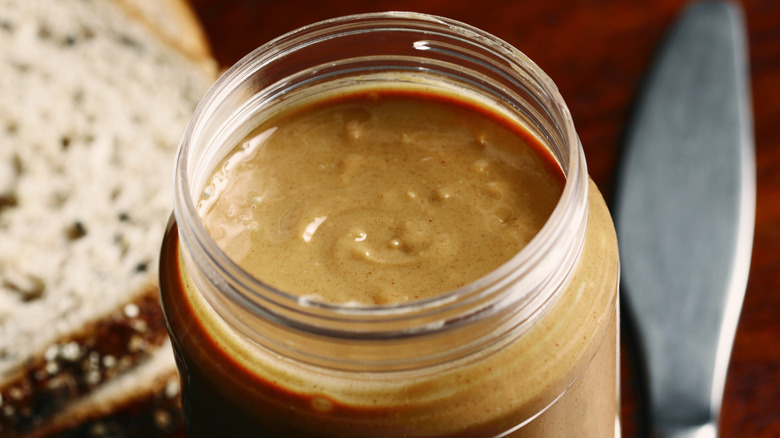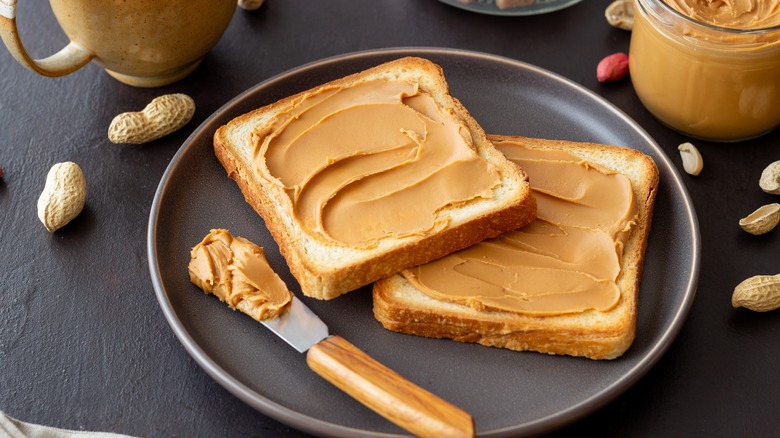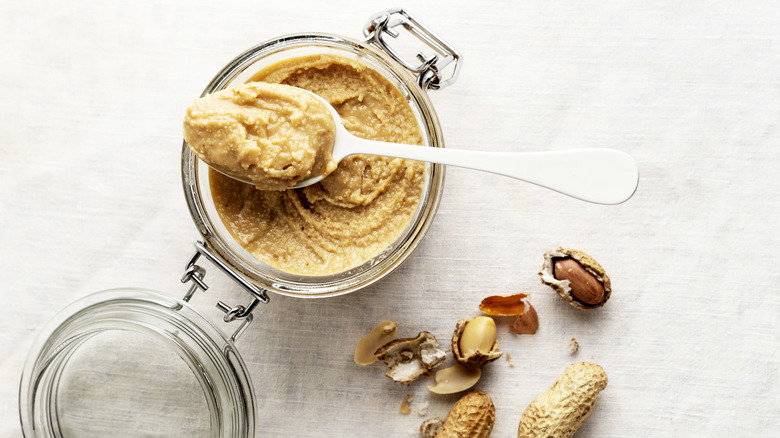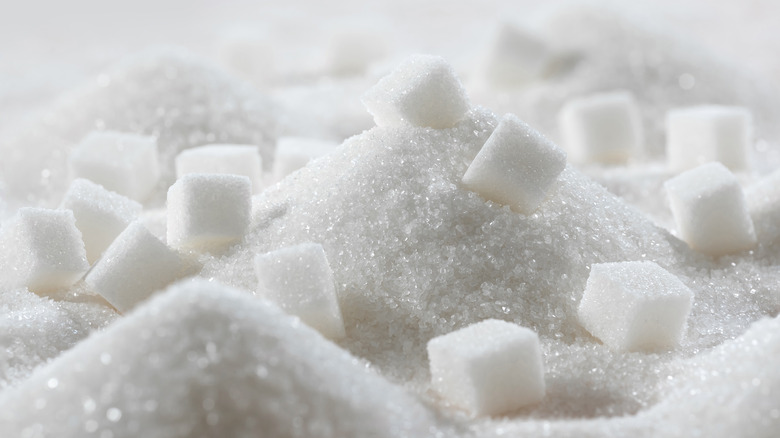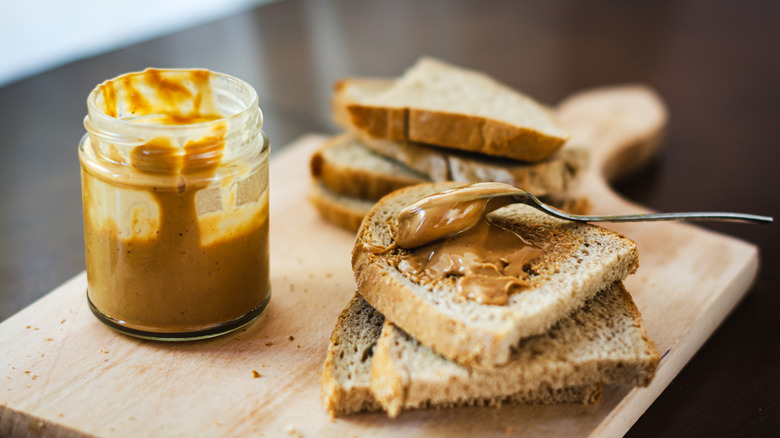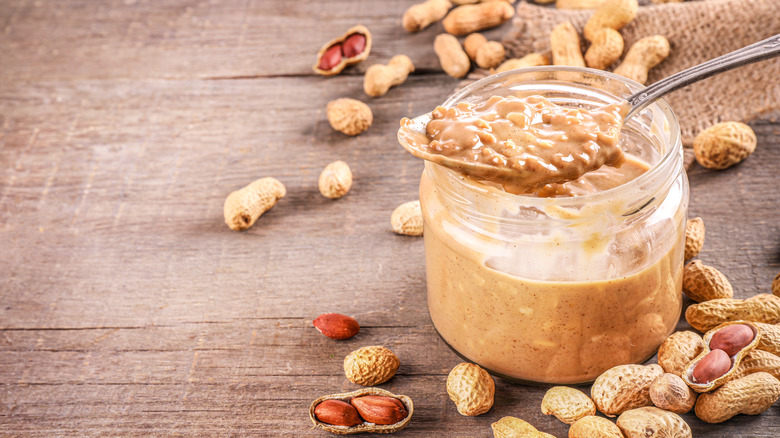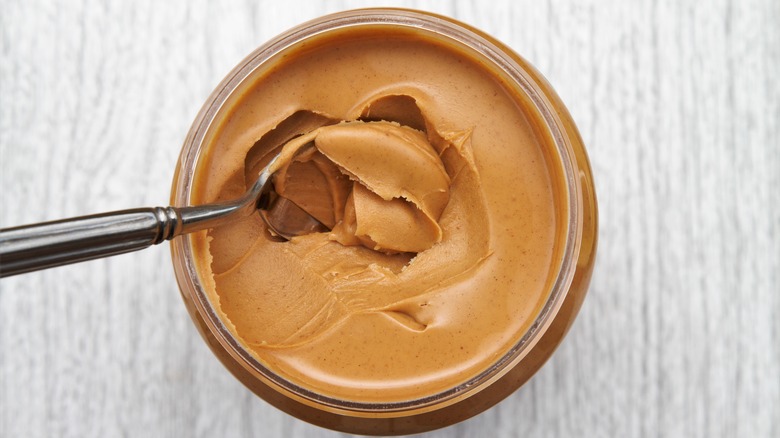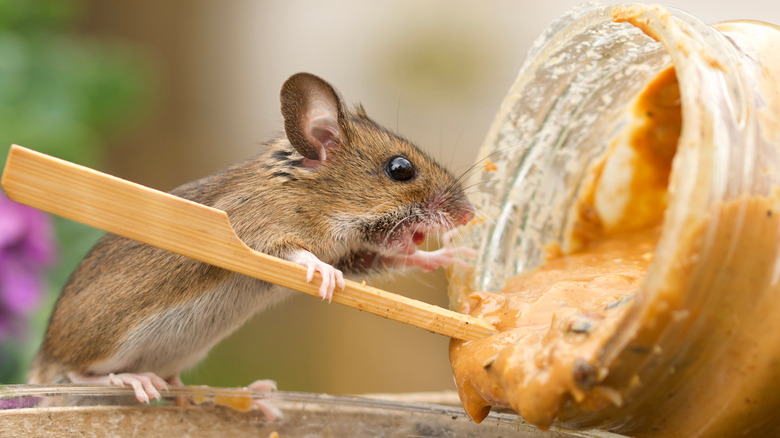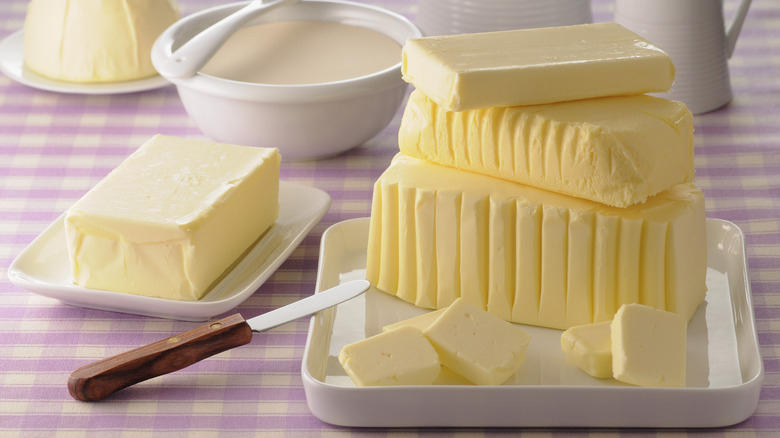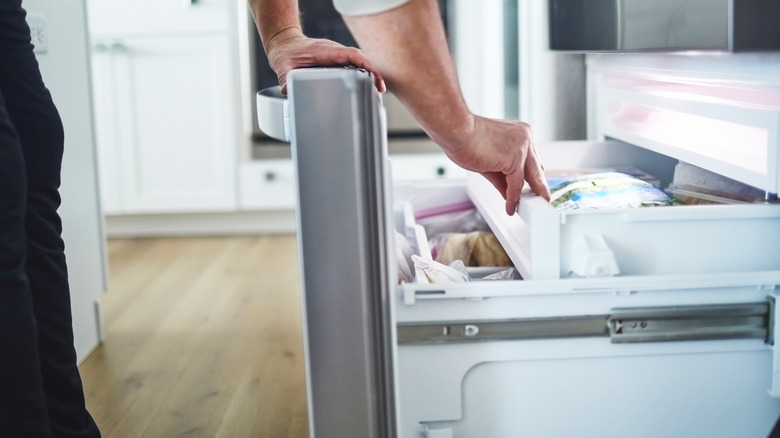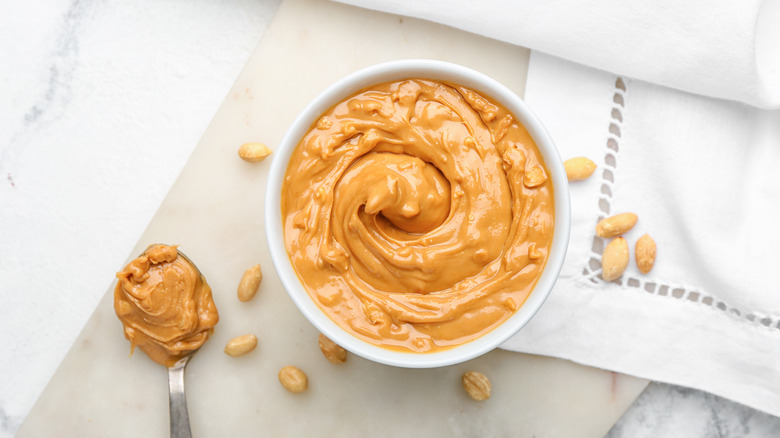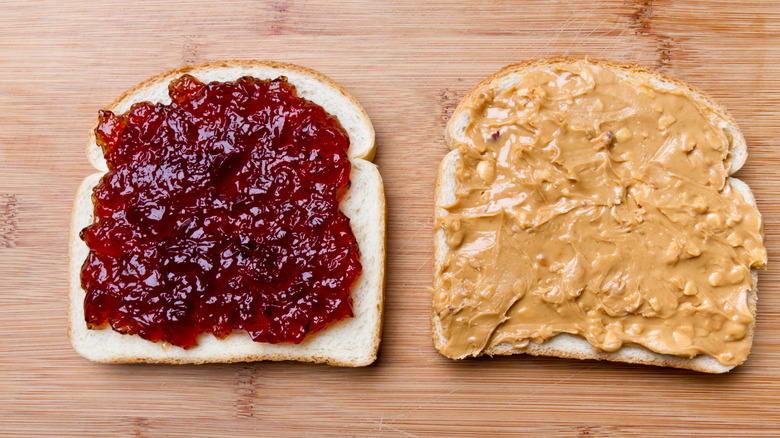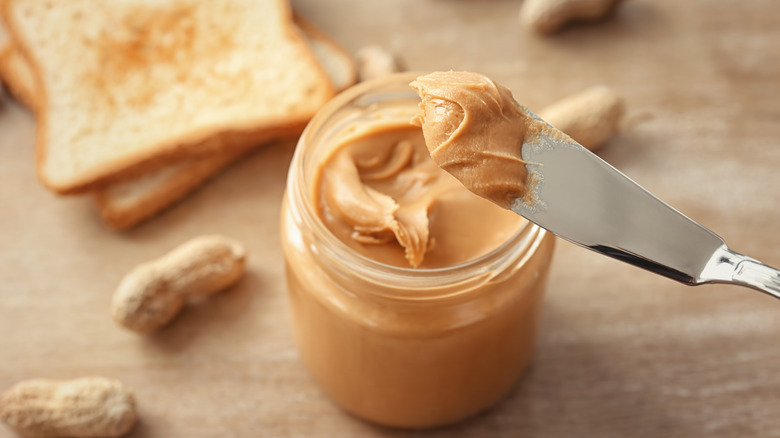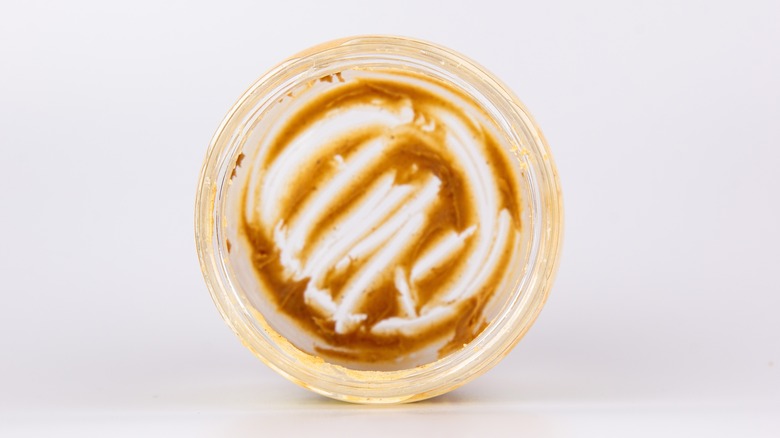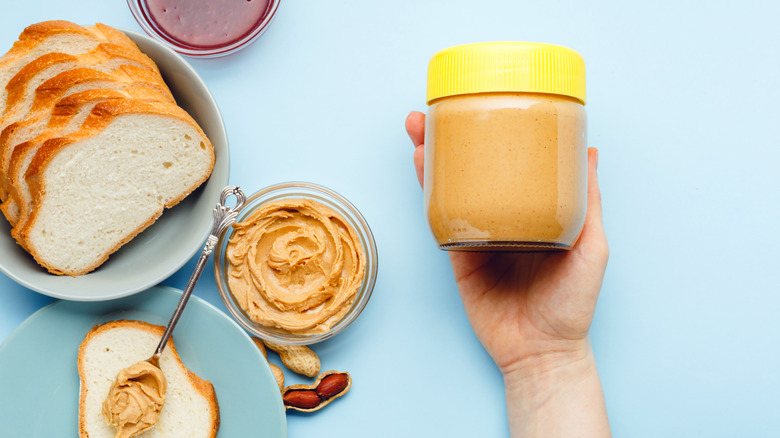14 Big Mistakes You Might Be Making With Peanut Butter
Peanut butter may have ancient beginnings, but today it's a thoroughly modern marvel. A food that was first created by the ancient Incas and Aztecs, modern peanut butter didn't start to take form until the late 19th century when Dr. John Harvey Kellogg patented the process of making it. The food quickly took off and has been almost unimaginably popular ever since. Almost 300 million people in the United States ate peanut butter at some point in 2020, according to Statista. The number of people eating peanut butter is only expected to grow, and this multi-billion dollar industry shows no signs of slowing down, with peanut butter finding itself into more and more foods beyond the humble jar in your pantry or fridge.
Part of why peanut butter is so popular, aside from its being an easy source of protein, is its versatility. This spread is at home in sweet foods as it is in savory ones, and it can be eaten at any time of the day in a dizzying array of recipes. But like any food item, things can go awry with it pretty quickly, and this seemingly-innocent product can cause you problems when stored, handled, or used incorrectly.
Spreading it so that it rips your bread
One of the biggest issues when it comes to peanut butter is its thickness. While this is definitely part of its appeal and gives the spread a luxurious, creamy mouthfeel, it can also make it difficult to handle — especially when spread onto delicate pieces of bread, where it has a tendency to rip the dough apart.
There are a few ways to stop this happening, however. The first and potentially easiest is to warm up the peanut butter slightly, which will make it more spreadable. Place the amount you need in a microwave-proof dish, and then microwave it for five seconds or so. You can also use smaller blobs of peanut butter dotted around the bread instead of trying to spread one big piece, which can be harder to maneuver.
The sturdiness of your bread can also make a big difference. Super-soft bread will rip far easier than a crusty loaf of dense rye bread or sourdough. To improve the sturdiness of soft white or brown bread, toasting it for a few minutes can help. Doing this and spreading the peanut butter while still warm can also have the added benefit of softening the spread.
Forgetting to stir it properly
Many store-bought jars of peanut butter will remain cohesive and won't require stirring, but natural nut butter is a different story. These nut butters don't contain any emulsifiers or hydrogenated oils that bind all the ingredients together. And as a result, they have a tendency to separate, with the oil rising to the top of the jar and the solid mass of spread sitting at the bottom. If you fail to stir it properly, you end up with a spread that's way too oil-heavy and unincorporated.
A quick and easy way to do this, though, is with an electronic hand mixer. Simply place it in your jar, press start, and allow the mixer to do its magic. A mixer is ideal for this action, as it can properly spread the oil through the butter instead of merely swirling it around. If your nut butter is particularly separated, it might be easier to scoop the whole thing out with a spatula and mix it in a bowl using a hand whisk or a spoon. You can then spoon the nut butter back into the jar and use it at your leisure.
Not checking the label
Peanut butter is well-known for being a high-energy, low-cost food, and it has a balanced energy profile that makes it a great addition to your diet. But different peanut butter recipes can vary widely, with some of them containing ingredients that ruin their nutritional value. A key thing you should keep an eye on is added sugars. These sugars, which can come in the form of high fructose corn syrup, corn syrup solids, or just regular sugar, can raise the sweetness and carbohydrate levels of peanut butter unnecessarily.
Hydrogenated and palm oil are other ingredients to look out for. Both of these can be added to improve the consistency of peanut butter, but they also boost the number of unhealthy fats in the spread, with palm oil containing saturated fats and hydrogenated oil supplying trans fats. As a general rule of thumb, you should try to look for a brand that has as few ingredients as possible. The ideal scenario is a nut butter containing simply peanuts and salt, which will provide you with all the nutritional positives of the nuts without any of the downsides of additional ingredients.
Tossing out your jar when there's still peanut butter left
A jar of peanut butter is heaven when it's full, but when it's almost spent, it can become a nightmare. Scraping peanut butter out of all the nooks and crannies of a jar can be hard work, and it can lead to people throwing it away with a significant amount of spread still inside. This can contribute to food waste and can cost you money — and with the average person losing approximately $375 a year to throwing perfectly good food out, it pays to learn how to get the peanut butter out of the jar.
The best thing to do is to find a way to incorporate peanut butter into a recipe that you can make directly in the jar. Make a peanut-based salad dressing by adding acid, sesame oil, and soy sauce into the jar and shaking it all up until smooth. The same thing can be done to make a peanut dipping sauce. If you'd prefer to spread your peanut butter, try microwaving the glass jar for a few seconds, provided that it's microwave-safe, which will soften it up slightly. With any luck, the peanut butter will then drip to the bottom of the jar, and you can then spoon it out.
Keeping natural peanut butter in the pantry
Big-brand peanut butter like Skippy and Jif create products that need to be treated way differently from smaller natural peanut butter options. These big names make conventional peanut butter, which contains stabilizers that stop them from separating. As these items are shelf-stable, they can be kept in your pantry for extended periods of time without any separation or deterioration in quality.
But natural peanut butter is different. These nut butters, which are usually just peanuts and salt, don't have the preserving capacity that the big brands have. "Because [natural peanut butter] does not have preservatives or stabilizers, it is best refrigerated to keep it fresh and to prevent the oil from separating out," says Margarethe A. Cooper via Martha Stewart. Keeping it in the fridge can help to slow any microbial action, stopping the peanut butter from growing mold. Additionally, "the separated oil in unrefrigerated natural peanut butter is more likely to become rancid sooner, leading to unpleasant taste and texture," Cooper says. Luckily, once your natural peanut butter is in the fridge, it'll stay edible for up to a year — but it's best to eat it within a few months, Cooper states.
Not using a spoon to spread your peanut butter
When most people go to spread peanut butter on bread, they reach for a knife. But that might not be the best utensil to use. Apart from butter knives, these kitchen items are generally pretty sharp and often have serrated edges, even on innocent-looking knives you'd use for dinner. This can increase the likelihood that you'll inadvertently cut through or rip your bread — which is made more likely by a knife's flatness.
Instead, you should be using a spoon, which celebrity chef Alton Brown points out is a superior utensil to a butter knife on Twitter. While Brown doesn't go into detail as to why, we can see the logic. The back of a spoon has a slight curve to it, which means that it's less likely to cut or tear your bread. The curved edge instead gently passes over the surface, pushing peanut butter more consistently across your dough. Depending on the size of the spoon you use, you may also be able to get more peanut butter per dip, saving the need to go back for more. And the back of a spoon is infinitely safer for licking the excess peanut butter than a knife is, where you run the risk of cutting your tongue.
Only using your peanut butter in food
Peanut butter fits into countless recipes, but it's even more versatile than you might think. In fact, there are a few things you didn't know you could do with peanut butter that doesn't involve food at all. Peanut butter's natural oils can work wonders for your skin and hair. You can use a small amount as a conditioner, rubbing it into your scalp and then rinsing it with a small amount of shampoo, or apply a thin coating as a shaving cream. The oils in the spread can also condition your furniture. Try rubbing some into your leather chairs or sofa before wiping it off. In all of these cases, it might be best to use natural peanut butter to ensure you're not rubbing any additional additives into your skin or furniture.
Peanut butter is also highly prized by certain animals for its flavor — and this can work to your advantage if you have pests. A small dollop of peanut butter in a humane mouse trap is a good way to lure unwanted house guests. Cockroaches and ants are also fans of peanut butter, and it can be used both to attract them and as a glue, making them easier to eliminate.
Forgetting you can use it in place of regular butter
Butter is used in recipes to provide moisture and richness, and it does so with its high-fat content and creamy taste. These qualities, though, are things that peanut butter can also deliver. This makes it the perfect substitute for regular butter, whether you've forgotten to buy a new stick or are allergic or intolerant of casein or whey, the two main proteins in butter that can prompt a reaction. It's also a great choice for individuals following a vegan diet.
Peanut butter is particularly useful as a butter replacement in baking recipes, where butter is often used to supply deep taste and reinforce the structure of baked goods. It's worth bearing in mind that peanut butter's fat content is lower than regular butter, as peanut butter has more protein and carbohydrates. To level things out, you should mix your peanut butter with the same amount of oil to bump up the fat levels. You can then substitute it in the same quantity as you would with butter. It's useful to remember that if you're seeking a neutral taste, you might be disappointed, as peanut butter will impart its nutty flavor to anything you're making.
Freezing it incorrectly
If you've bought way too much peanut butter and are struggling for storage, you're in luck. Peanut butter freezes very well and, if sealed properly, will last for approximately 6-9 months in the freezer before it starts to decline in quality. However, it's not quite as simple as just putting your jar in your deep freeze. The peanut butter will expand when it freezes, and this can create additional pressure from the inside of the jar. In the worst-case scenario, jars can split or shatter — and if you're using a glass jar, this can create a dangerous hazard.
As such, it's worth decanting your peanut butter into a plastic container, leaving enough space inside it for the spread to expand. You can also spoon your peanut butter into a Ziploc bag. Using one of these can be a space-saver, as you can flatten or mold the peanut butter into the shape you require instead of using bulky Tupperware. Leaving your peanut butter in the freezer for longer than 9 months isn't advised, as it could start to develop freezer burn, ruining its taste and texture. It's also worth mentioning that you may not need to freeze your peanut butter at all, as most products have a pretty long shelf life.
Assuming that all peanut butter is keto-friendly
The keto diet prompts fat loss by removing the vast majority of carbs from a diet and replacing them with fats and protein. And so, on the surface of things, peanut butter, with its high-fat, high-protein composition, seems like it would fit well in a keto diet plan. But while it's definitely true that some types of peanut butter are compatible with placing your body in ketosis, the state in which you burn fat when following this diet, according to Healthline. This is achieved by limiting carbohydrates; many types of peanut butter aren't compatible because of added sugars.
"Most peanut butters on the market add sugar into their product," states registered dietitian Dara Godfrey via Men's Health. And some types can add a surprisingly high amount. Peter Pan Creamy Honey Roast Peanut Butter Spread, for example, contains seven grams of added sugar per serving, which may take a significant chunk of your carbohydrate allowance when trying to achieve ketosis.
As such, "make sure to look for peanut butters with only up to two ingredients in them: peanuts, and maybe salt," advises Godfrey. It's important to remember that all peanut butter will contain some carbs to some extent, as peanuts themselves aren't carb-free. But by limiting the added sugars in your product, you can keep the impact minimal.
Making your PB&J the same way every time
Peanut butter and jelly is one of the all-time greats when it comes to sandwich filling combinations. But just because something's a classic doesn't mean it can't be improved upon. Mixing up the way you make a PB&J can open up new avenues for texture and flavor that make the sandwich even better. One of our favorite things to do is spread some butter on the outside of your PB&J sandwich and cook it like you would a grilled cheese. The outside of the sandwich will develop a rich, crunchy crust, while the peanut butter inside will melt, turning it into a luscious, indulgent meal. This can be done in a skillet or by putting your sandwich in a panini press.
For a next-level breakfast, try making PB&J stuffed French toast by making the sandwich, crimping its edges, and then coating the whole thing in your custard mixture before cooking. You can also try replacing the bread with something else entirely — try putting your filling between two waffles. Don't forget, too, that a PB&J can serve as a base on which you can put other toppings. For extra sweetness and some fiber and vitamins, add some fresh sliced fruit like strawberries or bananas. Or, to go all-out on flavor and indulgence, try adding cheese to your PB&J and grilling it.
Using peanut butter that's gone bad
You might think it lasts forever, but peanut butter does indeed go bad. Conventional peanut butter has a shelf-life of several months once it's been opened, while natural peanut butter will only stay fresh for about a month or so if kept in your pantry. In the fridge, both will last way longer, but after a certain amount of time, they'll start to spoil.
When assessing your peanut butter, trust your senses. If the spread has started to look hard, cracked, or darker than usual, there's a chance it's started to go bad. Spoiled peanut butter will also have a different smell than its usual peanut scent and may smell sour or harsh. The spread may also start to develop spots of mold on its surface.
It's worth remembering that the way that peanut butter spoils is due to its fat changing its structure and going bad, a process known as rancidification — and this may not be harmful. "It won't hurt you if you eat it — it will just taste bad. Some people actually eat rancid food without knowing it, depending upon their individual taste buds," explains Maribeth Cousin via Live Science. Regardless, it's highly recommended that you throw any rancid peanut butter out and get yourself a new jar.
Recycling your jars incorrectly
People in the United States have improved the number of goods they recycle enormously in the last few decades, with paper, glass, and plastic recycling all much more frequent since the year 2000, according to the United States Environmental Protection Agency. However, there's still a way to go. That's why recycling your peanut butter jars is so important — but the leftover residue that tends to be left over in each one can be difficult to clear away, and it can be difficult to know whether your jar is clean enough to be processed.
So here's the truth: Your peanut butter jars do have to largely be clean but not 100% free of leftovers. Spatula-clean is a good rule of thumb to go by, so once your jar is finished, insert a rubber spatula into it and scrape out all the residue you can get. Then, wash it out with hot water and dish soap, which should help to melt any scraps that you've missed. Arguably the most important step, though, is to make sure that it's dry. Any liquid or leftover oil that gets into the recycling process can contaminate other items and stop them from being processed.
Forgetting to store your jar upside down
While conventional peanut butter stays smooth and creamy thanks to its stabilizers, natural peanut butter has a bit more trouble. When the oil separates, it floats to the top, leaving peanut-dense sediment on the bottom and making it a nightmare to spread and serve easily.
There's a simple storage solution for this, though, and it's as easy as flipping the jar upside down. When you flip the peanut butter jar, the solid peanut paste at the bottom of it will sink, mixing with the oil at the top and redistributing everything properly. Then, when you come to use it, it should be way better incorporated.
Importantly, though, this trick will only work if you're using your peanut butter on a regular basis. Simply flipping your jar and leaving it there for months will just cause the oil to rise again, leaving you with the same problem — but adding the risk of all of your solid peanut butter getting stuck in the lid. A good rule of thumb is to turn the jar over every few days, to keep the oil and peanuts constantly mixing with each other.
